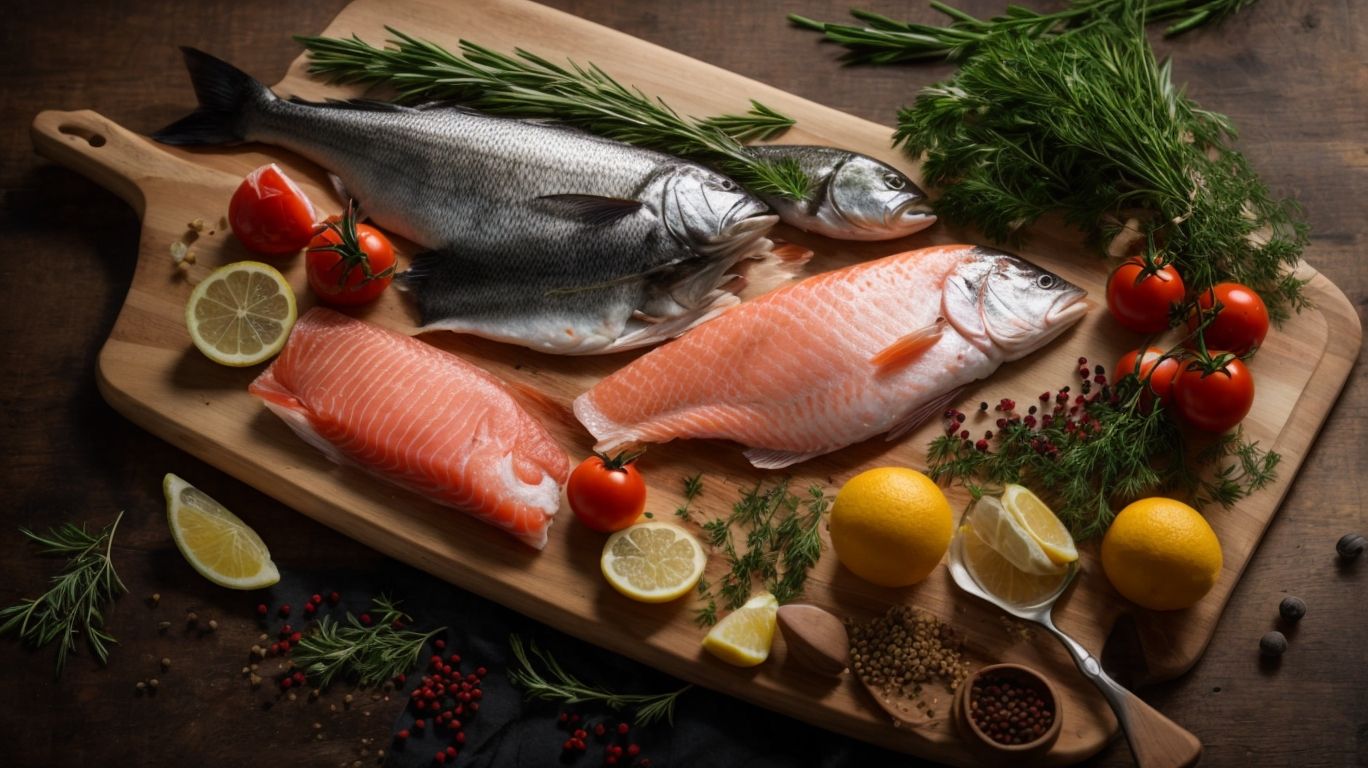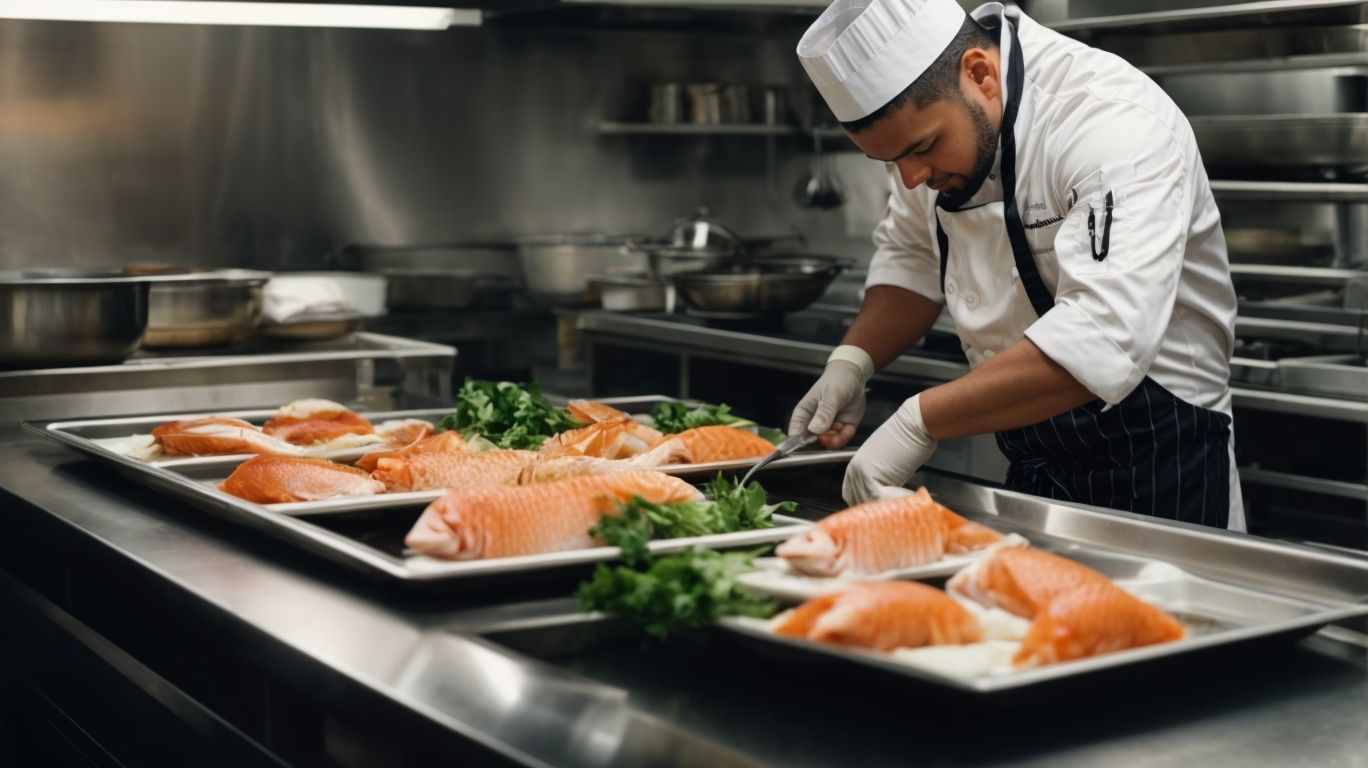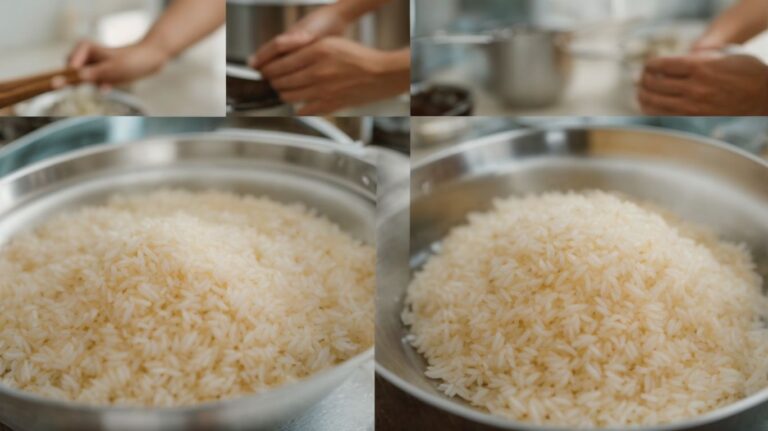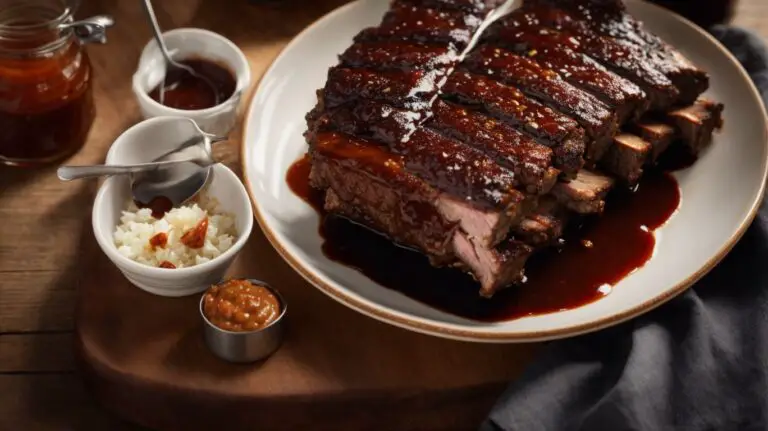How to Cook Fish?
Fish is not only delicious but also incredibly nutritious, making it a great addition to any diet.
We will explore the health benefits of eating fish, the different types of fish available, how to choose fresh fish, various ways to cook fish, and tips for cooking fish perfectly.
Whether you prefer baking, grilling, or pan-frying, we’ve got you covered with everything you need to know about cooking fish to perfection.
Let’s dive in and explore the wonderful world of fish cooking!
Key Takeaways:
Why Should You Cook Fish?

Credits: Poormet.Com – Anthony Rodriguez
Cooking fish is not only a delicious culinary experience but also offers numerous health benefits. Whether you’re a seafood enthusiast or looking to diversify your cooking skills, fish can be a rewarding ingredient to work with.
The allure of cooking fish lies in its incredible versatility. From delicate white fish like cod and sole to rich, flavorful options such as salmon and tuna, there is a type of fish to suit every palate. Fish’s unique taste profile allows it to be easily infused with a variety of flavors, making it a wonderful canvas for experimenting with different seasonings and cooking techniques.
The nutritional value of fish cannot be overstated. Rich in omega-3 fatty acids, high-quality proteins, vitamins, and minerals, fish is a powerhouse of nutrients that can support heart health, brain function, and overall well-being. Including fish in your diet can contribute to a balanced and healthy lifestyle.
Cooking fish can be a fulfilling endeavor for many reasons. Not only is it a quick-cooking protein that can be prepared in countless ways, but it also offers a wide range of textures and flavors to explore. Whether you prefer a simple grilled fillet, a fragrant seafood stew, or crispy fish tacos, the possibilities are endless when it comes to creating delicious fish dishes.
What Are the Health Benefits of Eating Fish?
Eating fish, especially varieties such as white fish fillets and salmon, offers a plethora of health benefits that contribute to overall well-being. From providing essential nutrients to promoting heart health, fish consumption has been linked to various positive outcomes.
White fish fillets, including cod and haddock, are not just delicious but also low in fat and high in quality protein. On the other hand, salmon is renowned for its rich content of omega-3 fatty acids, which are crucial for brain function and reducing inflammation.
These essential fatty acids found abundantly in fish play a significant role in reducing the risk of cardiovascular diseases by lowering blood pressure and improving overall heart health.
Along with omega-3 fatty acids, fish are a great source of key nutrients such as vitamin D and B vitamins, which are essential for maintaining good energy levels and supporting a healthy metabolism.
What Are the Different Types of Fish?
In terms of fish, there is a diverse range of options to explore, from delicate white fish fillets to rich and flavorful salmon varieties. Understanding the different types of fish available can open up a world of culinary possibilities.
White fish fillets, like cod and haddock, are mild in flavor and have a flaky texture, making them versatile for various cooking methods such as baking, grilling, or frying. On the other hand, salmon, known for its distinct pink-orange hue and buttery taste, is perfect for grilling, broiling, or even raw in sushi. Each type of fish demands specific cooking techniques to enhance its unique characteristics.
White Fish
White fish, including cod, haddock, bass, and other varieties, are known for their mild flavor and versatility in cooking. These fish species make excellent choices for dishes that require a light, delicate touch.
In terms of cooking white fish, the key is to enhance their subtle taste without overpowering it. Cod is popular for its firm texture, making it ideal for frying or baking. Haddock, with its sweet flavor, pairs well with lemon and herbs, perfect for grilling or pan-searing. Bass, on the other hand, is flaky and delicate, best cooked with a light seasoning to preserve its natural taste.
For flavor pairings, white fish such as cod can be complemented with garlic, parsley, and a squeeze of lemon for a refreshing dish. Haddock shines when combined with dill, capers, and a touch of white wine, adding depth to the flavor profile. Bass can be elevated with flavors like thyme, butter, and shallots, creating a luxurious taste experience.
As for recipe ideas, consider preparing a classic Fish and Chips with cod, serving it with homemade fries and tartar sauce for a comforting meal. Try a flavorful Haddock Chowder, incorporating potatoes, corn, and cream for a hearty and satisfying dish. For a gourmet option, pan-sear bass fillets and serve them over a bed of asparagus risotto, infused with parmesan and lemon zest.
Fatty Fish
Fatty fish like salmon and trout are rich in omega-3 fatty acids, making them not only flavorful but also beneficial for heart health and overall well-being. Incorporating fatty fish into your diet can offer a range of nutritional advantages.
These fatty fish varieties are known for their high levels of omega-3 fatty acids, which are essential for brain function and reducing inflammation in the body. Research suggests that consuming omega-3s from sources like salmon and trout can lower the risk of heart disease and stroke.
Cooking fatty fish is a versatile process – whether grilled, baked, or pan-seared, their natural oils and rich flavors complement a variety of seasonings and sauces. Salmon can be marinated in a zesty lemon herb mixture, while trout pairs beautifully with a hint of garlic and butter.
For a delicious recipe idea, try making salmon en papillote – wrapping the fish in parchment paper with vegetables and herbs before baking. This method locks in moisture and flavors, creating a tender and aromatic dish that is both healthy and satisfying.
Shellfish
Shellfish, including shrimp, crab, and lobster, are prized for their succulent meat and briny flavors. These delicacies from the sea offer a luxurious dining experience and can be prepared in a variety of delectable ways.
Shrimp is known for its tender texture and sweet taste, making it a versatile ingredient in numerous dishes. Whether grilled, sautéed, or fried, shrimp adds a delightful flavor to pastas, salads, and stir-fries.
On the other hand, crab meat is celebrated for its rich, buttery quality, perfect for crab cakes, bisques, or simply dipped in melted butter.
Moving on to lobster, this delicacy with its firm yet delicate flesh is often steamed or grilled, elevating seafood platters or luxurious surf and turf recipes to new heights.
The unique textures and flavors of these shellfish lend themselves well to various culinary creations, offering a gourmet touch to any meal.
How to Choose Fresh Fish?
Selecting fresh fish is crucial to achieving optimal taste and quality in your seafood dishes. By understanding key indicators such as appearance, smell, and texture, you can make informed choices when purchasing fish from a reliable fish seller.
When evaluating the freshness of fish, one of the first things to look at is the eyes. The eyes of a fresh fish should be clear, not cloudy or sunken. Next, check the gills; they should be bright red or pink in color, not brownish or slimy. The skin of the fish should be shiny and scales intact. A reputable fish seller is essential, as they will have proper storage and handling practices in place. Utilizing tools like a fish spatula can help you gently handle and inspect the fish without damaging it.
Look at the Eyes and Gills
Inspecting the eyes and gills of a fish is an essential step in determining its freshness and quality. Clear, bright eyes and vibrant, red gills are indicators of a fresh catch, ensuring that you can enjoy premium seafood in your culinary creations.
When purchasing fish, remember that the eyes of a fish should be bulging and glossy, with pupils that are not cloudy or sunken.
The gills, on the other hand, should be a deep red color, free of any slime or odor, signaling that the fish is still full of oxygen and nutrients.
These visual cues can help you make informed decisions when selecting fish from the market or a restaurant, ensuring that you get the freshest and most flavorful options available.
Check the Smell
The aroma of fresh fish should be mild, briny, and reminiscent of the ocean. By trusting your sense of smell and avoiding strong, fishy odors, you can ensure that the fish you select is of superior quality and suitable for cooking delicious meals.
When choosing fresh fish, it’s essential to pay attention to the olfactory cues it presents. A clean, oceanic scent is an indicator of freshness and quality. Keep an eye out for any hints of ammonia, a telltale sign of fish that is past its prime. If the fish smells overly fishy or pungent, it’s best to steer clear, as these odors can indicate spoilage or improper handling. Opt for fish from reputable sellers who prioritize proper storage and handling to guarantee a delightful aroma and excellent taste in your culinary creations.
Examine the Texture
The texture of fresh fish should be firm, resilient, and free from any mushiness or sliminess. By running your fingers over the fish’s surface and feeling for elasticity, you can ensure that you’re choosing a high-quality product from a reputable fish seller.
When choosing fresh fish, it’s essential to pay attention to the firmness of the flesh. A good quality fish will feel sturdy and plump under your touch, indicating freshness and a well-preserved state. Elasticity is a crucial indicator of freshness – the fish should bounce back when pressed lightly, showing resilience and freshness. Avoid fish that feels mushy or leaves a sticky residue on your fingers, as these are signs of deterioration.
What Are the Different Ways to Cook Fish?

Credits: Poormet.Com – George Nelson
Cooking fish offers a spectrum of culinary possibilities, from baking and grilling to pan-frying and poaching. Each cooking method imparts unique flavors and textures to the fish, allowing you to experiment with diverse techniques and recipes.
Baking fish involves cooking it in an oven, often wrapped in foil or parchment paper to retain moisture. This gentle cooking method is ideal for delicate fish like cod, tilapia, or salmon. Seasonings such as lemon, dill, and garlic work well with baked fish, infusing it with bright and fresh flavors.
Grilling fish over an open flame or on a grill pan imparts a smoky charred flavor. Firm fish like swordfish, tuna, or mahi-mahi are great for grilling. Marinades with citrus, herbs, and spices enhance the natural taste of the fish and add depth to the dish.
Baking
Baking fish in the oven is a popular method that yields moist, flaky fillets with a crispy exterior. By utilizing flavorful ingredients like lemon butter sauce and seasonings, you can create delectable baked fish dishes that are both simple to prepare and delightful to savor.
Once you have selected your preferred fish, such as salmon or cod, preheat the oven for optimal cooking results. To ensure the fish stays moist, consider wrapping it in parchment paper or foil before placing it in the oven.
For added flavor, drizzle a mixture of olive oil, garlic, and herbs over the fish before baking. This will infuse the fillets with delicious aromas while enhancing their taste profile.
Remember to season generously with salt, pepper, and any other herbs or spices of your choice. This step is crucial in developing a well-rounded flavor profile that complements the natural taste of the fish.
Grilling
Grilling fish over an open flame imparts a smoky flavor and charred finish that elevates the dish’s taste. Whether using a barbecue or grill pan, grilling fish offers a quick and flavorful cooking method that can be enhanced with marinades and seasonings like rainbow trout fillets.
-
Marinating the fish beforehand can not only add depth to the flavor but also aid in keeping the fish moist during cooking, preventing it from drying out on the grill.
-
Choosing the right grilling tools, such as a fish basket or a cedar plank, can make grilling fish easier and prevent it from sticking to the grill grates.
-
When selecting fish for grilling, opt for varieties like salmon, tilapia, or swordfish that are firm and can withstand the direct heat of the grill without falling apart.
Pan-frying
Pan-frying fish in a skillet creates a crispy exterior while keeping the fillets tender and moist inside. With the right amount of heat and oil, pan-frying allows you to achieve a golden brown crust and delicious flavor, especially when using quality olive oil.
When selecting oil for pan-frying, opt for those with high smoke points like grapeseed or canola oil to prevent burning and impart a neutral taste. Make sure the skillet is preheated before adding the fish to ensure that satisfying sizzle upon contact. Season the fillets generously with salt, pepper, and your favorite herbs or spices before placing them in the hot skillet.
Poaching
Poaching fish involves gently simmering it in a flavorful liquid, resulting in tender and delicate fillets. The subtle cooking method of poaching allows the fish to absorb aromatics like garlic salt, creating a dish that is both light and infused with nuanced flavors.
For those looking to enhance the flavor profile further, incorporating ingredients such as fresh herbs like dill or parsley can elevate the overall taste of the poached fish. A dash of lemon juice added to the poaching liquid can provide a refreshing citrusy zing, balancing the richness of the fish.
When poaching fish, it’s crucial to maintain a low simmer to avoid overcooking the delicate fillets. Patience is key in this process, as the slower cooking time ensures the fish remains moist and doesn’t dry out.
Steaming
Steaming fish is a healthy and low-fat cooking method that preserves the fish’s natural flavors and nutrients. By using techniques like seasoning with black pepper and steaming over aromatic ingredients, you can create light and flavorful steamed fish dishes.
One of the key benefits of steaming fish is that it helps to lock in the fish’s moisture and nutrients, unlike other cooking methods that can cause nutrient loss. Steaming allows the fish to cook gently and evenly, resulting in a tender and flaky texture. Experimenting with different seasoning options, such as citrus zest or fresh herbs, can elevate the taste profile of the dish without adding excess calories or unhealthy fats.
Broiling
Broiling fish in the oven under high heat results in a quick and flavorful cooking method that produces caramelized edges and moist interiors.
Using aluminum foil when broiling fish helps to prevent sticking to the pan and retains moisture during cooking, resulting in tender fish fillets. Marinating the fish before broiling can infuse it with extra flavors and keep it juicy. For a simple marinade, mix olive oil, lemon juice, garlic, and herbs such as parsley or dill. Once the fish is cooked, consider serving it with a squeeze of fresh lemon juice or a light dill sauce to complement its natural taste.
Sautéing
Sautéing fish in a skillet allows for quick cooking and flavorful results, with the added benefit of creating a golden-brown crust.
When sautéing fish, it’s essential to heat the skillet properly before adding the fish to ensure a good sear. You can enhance the dish by finely chopping a jalapeno pepper for a subtle heat that complements the fish’s natural flavors. To prevent the fish from sticking to the pan, use a thin layer of oil and avoid overcrowding the skillet. Season the fillets generously with spices like paprika, cumin, and garlic powder for a well-rounded taste profile.
What Are Some Tips for Cooking Fish Perfectly?

Credits: Poormet.Com – Albert Robinson
Achieving perfectly cooked fish requires attention to detail in seasoning, cooking time, temperature control, and proper preparation. By mastering these essential tips, you can elevate your seafood dishes and create memorable dining experiences.
In terms of seasoning fish, an important tip is to use a delicate hand to avoid overpowering the natural flavors of the seafood. A simple blend of salt, pepper, and a squeeze of lemon can work wonders. Understanding cooking temperatures is crucial; fish cooks quickly, so ensure your pan or oven is preheated to the right temperature before adding the fish for a perfect sear.
- Preparation is key – ensure your fish is properly cleaned and patted dry to prevent excess moisture during cooking. This step is vital for achieving a crispy skin or tender flesh.
- Experiment with different flavor combinations to enhance the natural taste of different fish varieties. Dill, parsley, and garlic complement delicate white fish, while cumin, paprika, and chili powder can give a flavorful kick to heartier fish like salmon or tuna.
Seasoning
Seasoning fish with the right balance of salt and pepper can enhance its natural flavors and bring out the best in each bite. Whether using a simple seasoning blend or experimenting with bold spices, mastering the art of seasoning is key to perfecting your fish dishes.
In terms of seasoning fish, one must understand that salt is not just about adding flavor; it plays a crucial role in tenderizing the fish and drawing out excess moisture during the cooking process. Pepper, on the other hand, lends a subtle heat and depth to the dish, complementing the delicate flavors of seafood.
For those looking to elevate their dishes further, incorporating other flavor enhancers such as garlic, lemon zest, herbs like dill or parsley, or spices like paprika can take your fish to a whole new level of taste sensation.
Cooking Time and Temperature
Understanding the optimal cooking time and temperature for different fish types is essential to prevent overcooking or undercooking. By employing precise techniques and monitoring cooking times closely, you can ensure that your fish is cooked to perfection every time.
Cooking fish requires a delicate balance between time and temperature to retain its natural flavors and texture. When grilling fish, it’s crucial to preheat the grill properly to the recommended temperature based on the type of fish you are cooking. Thicker cuts like salmon or swordfish need lower heat and longer cooking times to ensure even cooking without drying out.
Adjusting the cooking time based on the thickness of the fish is a crucial skill to master. For each inch of fish thickness, approximately 10 minutes of cooking time is recommended at the appropriate temperature. Utilizing a thermometer to check the internal temperature of the fish can help you achieve consistent results.
Properly Prepping the Fish
Properly prepping fish by cleaning, deboning, and marinating with ingredients like olive oil and garlic salt can significantly impact the final dish’s taste and texture. Taking care during the preparation stage ensures that your fish dishes are flavorful, aromatic, and visually appealing.
When cleaning the fish, make sure to remove any scales, entrails, and bloodline to enhance the overall flavor profile. Deboning the fish is crucial to prevent any unwanted bones from ruining your dining experience. Marinating allows flavors to infuse deeply into the flesh, creating a harmonious taste.
- Experiment with marinating times based on the fish’s thickness – thinner fillets may need less time than thicker cuts.
- Combine olive oil with herbs like parsley, thyme, or dill for a refreshing taste.
- Season with salt, pepper, and a touch of citrus for a burst of tangy zest.
These seasoning tips can transform a simple fish dish into a culinary masterpiece, captivating your taste buds with each bite!”
Conclusion
Cooking fish offers a delightful culinary experience that combines taste, health benefits, and creative exploration in the kitchen. Whether you’re a seafood aficionado or a novice chef, mastering the art of cooking fish can lead to flavorful dishes and memorable dining moments.
Experimenting with different types of fish and cooking techniques opens up a world of flavors and textures. From pan-seared salmon to grilled trout or baked sea bass, the possibilities are endless. Incorporating fish into your regular cooking routine not only adds variety to your meals but also provides essential nutrients like Omega-3 fatty acids, protein, and vitamins. This versatile ingredient can be adapted to various cuisines, allowing you to explore diverse culinary traditions and expand your palate.
Frequently Asked Questions
What are some essential ingredients for cooking fish?
Some essential ingredients for cooking fish include salt, pepper, olive oil, herbs and spices, lemon, and garlic.
How do I know when fish is fully cooked?
A fully cooked fish will be opaque in color, flaky, and easily flakes apart with a fork. The internal temperature should reach 145°F.
What are some common methods for cooking fish?
Some common methods for cooking fish include baking, pan-frying, grilling, poaching, and steaming.
Can I cook frozen fish?
Yes, you can cook frozen fish, but it may take longer to cook. It’s best to thaw it in the refrigerator beforehand for even cooking.
What types of fish are best for grilling?
Firm and meaty fish like salmon, swordfish, tuna, and halibut are best for grilling. They hold up well on the grill and have great flavor.
How can I prevent fish from sticking to the pan?
To prevent fish from sticking to the pan, make sure the pan is preheated and well-oiled. You can also lightly dust the fish with flour or cornmeal before cooking.






